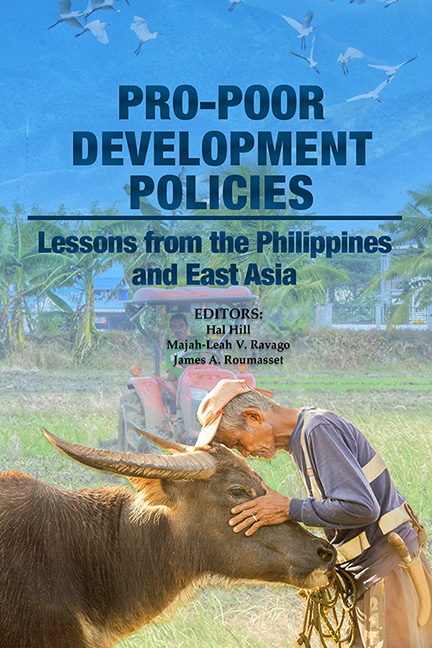Book contents
- Frontmatter
- Dedication
- Contents
- Figures, Tables and Boxes
- Foreword
- Foreword
- Message
- Preface and Acknowledgements
- About the Editors
- About the Contributors
- Acronyms
- Part 1 Introduction and Synthesis
- Part 2 Agricultural and Economic Development
- Part 3 Economic Policies for Achieving Targeted Levels of Living in the Philippines
- Part 4 Inequality and Economic Development
- Part 5 Competition Law and Policy
- Part 6 International Dimensions
- Index
9 - Low Income Traps and Philippine Poverty Incidence
Published online by Cambridge University Press: 09 January 2024
- Frontmatter
- Dedication
- Contents
- Figures, Tables and Boxes
- Foreword
- Foreword
- Message
- Preface and Acknowledgements
- About the Editors
- About the Contributors
- Acronyms
- Part 1 Introduction and Synthesis
- Part 2 Agricultural and Economic Development
- Part 3 Economic Policies for Achieving Targeted Levels of Living in the Philippines
- Part 4 Inequality and Economic Development
- Part 5 Competition Law and Policy
- Part 6 International Dimensions
- Index
Summary
INTRODUCTION
A notable feature of the Philippine economy post-Asian financial crisis and until fairly recently had been the slow response of income poverty to fairly robust economic growth (Balisacan 2011; Balisacan 2010; Balisacan 2009; Ducanes and Balisacan 2019; World Bank 2011; ADB 2009). This contrasts with the experience of China and Vietnam (Balisacan, Pernia, and Estrada 2003), where poverty markedly declined as their economies grew in the decade following the Asian financial crisis, as well as with other countries in the region whose economies grew even earlier, such as Thailand and Malaysia. The income elasticity of headcount poverty was estimated to be only −1.3 in the Philippines, compared with −2.3 for East Asia as a whole (World Bank 2011).
We argue in this paper and show empirically using regional-level data that the reason for the slow response of income poverty to economic growth in the Philippines is the erstwhile pattern of economic growth, which had been dominated by higher-end services. From 2012 to 2015, as the pattern of economic growth began to favour industry, a strong poverty response has been observed.
The transformation of rural employment from a largely informal to a largely formal sector activity as the root cause of modernization and development follows the Ranis-Fei model (Ranis and Fei 1964). The Ranis-Fei model of growth envisions a dual economy with, on one hand, a backward economy serving as a sink for surplus labour and with a low fixed wage level and, on the other, a modern sector with rising productivity and high wages, courtesy of modern technology, large capital complement and scale economies. The transfer of labour from the backward sector to the modern sector underpins economic growth and the rise in income. As the process unfolds, average incomes of households in the backward economy are pulled up and poverty drops. A clear case is Taiwan’s development in the 1960s, where rural incomes rose and rural poverty incidence fell with the increasing availability of rural non-farm employment (Anderson and Leiserson 1980).
Another development paradigm apropos the relationship between industrial structure and poverty reduction is development progeria, which applies to low-income countries.
- Type
- Chapter
- Information
- Pro-poor Development PoliciesLessons from the Philippines and East Asia, pp. 223 - 245Publisher: ISEAS–Yusof Ishak InstitutePrint publication year: 2022

